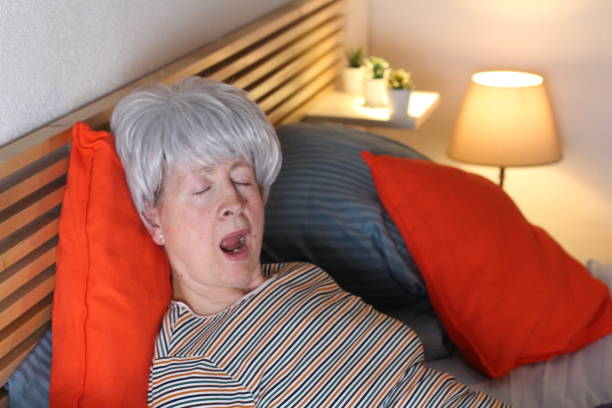Introduction

Unravelling the mysteries of Parkinson's disease has been an ongoing pursuit in the medical community, and recent advancements have shed light on a surprising connection—breathing patterns during sleep. While the traditional motor symptoms of Parkinson's, such as tremors and stiffness, have long been recognized, researchers have begun to explore how changes in respiration during sleep can serve as potential indicators for the onset and progression of this debilitating neurological disorder.
This blog post explores the fascinating connection between breathing patterns during sleep and Parkinson's disease and discusses how this could potentially aid in detecting the disease early and enhancing patient care.
What is the Parkinson's Disease?

The central nervous system is affected by Parkinson's disease, a progressive neurodegenerative disorder. Symptoms commonly experienced by individuals with this disease include tremors, stiffness, and impaired balance, primarily affecting movement. It primarily impacts movement and is characterized by symptoms such as tremors, stiffness, and impaired balance. However, Parkinson's disease is not limited to motor symptoms; it can also affect various non-motor functions, including sleep.
Sleep and Parkinson's Disease
Quality sleep is crucial for overall well-being; individuals with Parkinson's disease often experience sleep-related issues. Disturbances during sleep can worsen the symptoms of Parkinson's disease and harm an individual's quality of life. Sleep disorders commonly associated with Parkinson's include insomnia, excessive daytime sleepiness, restless legs syndrome, and rapid eye movement (REM) sleep behavior disorder.
Can Parkinson's affect breathing patterns?
Yes, changes in breathing patterns can be a symptom of Parkinson's Disease. Studies have shown that people with Parkinson's often experience pauses in their breathing during sleep and when awake. This is known as "sleep-disordered breathing" (SDB). SDB includes obstructive sleep apnea (OSA) and hypopnea (abnormally shallow breathing).
These pauses in breathing can cause oxygen levels to drop significantly, leading to various health problems. For example, people with Parkinson's' can experience higher blood pressure, irregular heartbeat, dizziness, and insomnia.
The Link Between Breathing Patterns and Parkinson's Disease

Researchers have recently discovered a connection between abnormal breathing patterns during sleep and the presence of Parkinson's disease. Several specific sleep disorders are prevalent among Parkinson's patients and may serve as potential indicators of the disease.
REM Sleep Behavior Disorder
REM sleep behavior disorder (RBD) is a condition in which individuals act out their dreams during REM sleep. It involves the absence of normal muscle atonia during REM sleep, leading to vivid and often physically active dream enactment. RBD has been identified as a potential marker for the development of Parkinson's disease, as many individuals with RBD eventually develop the condition or other neurodegenerative disorders.
Sleep Apnea
Breathing interruptions during sleep are a common result of sleep apnea, typically caused by the collapse of the upper airway. Studies have shown a higher prevalence of sleep apnea in individuals with Parkinson's disease than in the general population. Additionally, sleep apnea may contribute to cognitive decline and worsen motor symptoms in Parkinson's patients.
Periodic Limb Movements in Sleep
Periodic limb movements in sleep (PLMS) refer to repetitive movements of the limbs during sleep. Experiencing such movements can disrupt your sleep and lead to excessive daytime sleepiness. Although PLMS can occur in anyone, they are more frequently seen in individuals with Parkinson's disease. While PLMS can happen to anyone, they are more common in those with Parkinson's disease. Their presence, along with abnormal breathing patterns, may indicate the presence of the condition.
Recognizing Abnormal Breathing Patterns
Recognizing abnormal breathing patterns during sleep is crucial for identifying potential signs of Parkinson's disease. While not everyone with breathing issues during sleep will develop Parkinson's, being aware of these patterns can prompt individuals to seek medical evaluation.
Snoring and Gasping for Air
Loud and persistent snoring, accompanied by gasping for air during sleep, may indicate the presence of sleep apnea. If these symptoms are present in conjunction with other Parkinson's-related symptoms, it is advisable to consult a healthcare professional for further evaluation.
Changes in Breathing Rate
Individuals with Parkinson's disease may experience changes in their breathing rate during sleep. These changes can manifest as periods of rapid breathing followed by slower, irregular breathing patterns. Monitoring breathing rates during sleep can provide valuable insights for medical professionals.
Irregular Breathing
Irregular breathing patterns, such as long pauses between breaths or shallow breathing, can also indicate sleep disturbances in individuals with Parkinson's disease. Various factors, including sleep apnea, RBD, or other sleep-related disorders, may cause these irregularities.
Diagnosing Parkinson's Disease Through Breathing Patterns
It's possible that irregular breathing during sleep could suggest Parkinson's disease, but only a healthcare professional can provide a definite diagnosis. If someone suspects they may have Parkinson's disease, it is crucial to consult a neurologist or sleep specialist who can conduct a thorough evaluation.
Treatment and Management
While a definitive cure for Parkinson's disease remains elusive, numerous treatment options are available that effectively relieve its symptoms and greatly improve the overall quality of life for individuals affected by this condition.
Medication and Therapy
Medication, such as levodopa and dopamine agonists, can help alleviate motor symptoms and improve sleep quality in individuals with Parkinson's disease. Moreover, including physical therapy, occupational therapy, and speech therapy can prove advantageous in managing the condition.
Lifestyle Changes
Incorporating a healthy lifestyle can positively impact managing Parkinson's disease. Engaging in regular exercise, maintaining a balanced diet, and implementing stress management techniques can contribute to improved overall well-being and enhanced sleep quality.
How Breathing Patterns Can Indicate Parkinson's Disease
The exact mechanisms behind altered breathing patterns in Parkinson's disease are not fully understood. However, it is believed that the degeneration of dopamine-producing cells in the brain may disrupt the neural circuits responsible for controlling respiration.
Specific breathing patterns, such as shallow or irregular breathing, have been identified as potential indicators of Parkinson's disease. These patterns may occur before other noticeable symptoms develop, making them valuable for early detection.
Furthermore, research has shown that breathing disturbances during sleep in individuals with Parkinson's disease are associated with other symptoms, such as cognitive decline and autonomic dysfunction. Understanding these correlations can provide a more comprehensive picture of the disease's progression.
Diagnostic Potential and Challenges
The potential of using breathing patterns as a diagnostic tool for Parkinson's disease is promising. It offers a non-invasive and cost-effective method that could be integrated into routine healthcare practices. Nevertheless, before widespread implementation can take place, several challenges must be addressed.
One challenge is the standardization and validation of the methods for tracking and analyzing breathing patterns. Further research is needed to establish the accuracy and reliability of these techniques across different populations and settings.
Additionally, breathing pattern analysis should be viewed as something other than a standalone diagnostic tool but rather as a complementary approach to existing methods. Combining multiple diagnostic modalities can improve accuracy and reduce the risk of misdiagnosis.
Future Implications
If the correlation between breathing patterns during sleep and Parkinson's disease continues to be validated, it could have significant implications for early diagnosis and treatment. Identifying individuals at risk or in the early stages of the disease would allow for timely interventions and personalized care plans.
Furthermore, integrating breathing pattern analysis into healthcare systems could enhance the overall management of Parkinson's disease. Continuous monitoring of breathing patterns could provide valuable data for assessing treatment effectiveness, disease progression, and the impact of interventions.
Can AI detect Parkinson's from nighttime breathing patterns?
While research is ongoing in the field of using AI to detect Parkinson's disease from nighttime breathing patterns, there is evidence to suggest that analyzing breathing patterns during sleep can indeed indicate the presence of Parkinson's disease.
Breathing patterns during sleep could be analyzed using AI, which may provide a non-invasive and potentially early diagnostic tool for Parkinson's disease. Parkinson's is a medical condition that impacts movement and occurs due to the reduction of brain cells responsible for producing dopamine in the neurological system. Timely diagnosis of Parkinson's is essential for effective treatment and management.
Breathing patterns during sleep can provide valuable insights into an individual's health and the presence of certain conditions. Studies have shown that individuals with Parkinson's disease exhibit distinct breathing abnormalities during sleep, such as decreased respiratory amplitude and increased irregularity in respiratory patterns. These breathing disturbances may occur before other noticeable symptoms develop, making them valuable for early detection.
The use of AI in analyzing nighttime breathing patterns involves the application of machine learning algorithms to large datasets of respiratory data.
AI algorithms have the potential to be trained in recognizing patterns and identifying breathing anomalies that are indicative of Parkinson's disease. By analyzing the data collected during sleep, AI models can identify specific breathing patterns associated with the disease, potentially aiding in early detection and diagnosis.
However, it's important to note that AI-based detection of Parkinson's disease from nighttime breathing patterns is still in the research and development stage. More research is required to confirm the precision and dependability of AI algorithms in this situation. Additionally, integrating AI systems into healthcare practices requires careful consideration of ethical and privacy concerns and collaboration between medical professionals and AI experts.
Finally, while AI has the potential to detect Parkinson's disease from nighttime breathing patterns, more research is needed to fully understand and validate its effectiveness. Analyzing breathing patterns during sleep offers a promising avenue for early diagnosis, but it should be considered a complementary approach alongside other diagnostic methods. With continued advancements in AI technology and further research, AI may play a significant role in improving the detection and management of Parkinson's disease.
FAQ's
How does Parkinson's cause sleep apnea?
Sleep apnea, where breathing pauses or becomes shallow during sleep, can be caused by Parkinson's disease. This happens because the nerve signals that control breathing muscles are impaired, leading to irregular and lessened breathing during sleep.
Does Parkinson's cause obstructive sleep apnea?
When a person has Parkinson's disease, they may also develop a sleep disorder called obstructive sleep apnea. This condition causes breathing to be interrupted because the airway is blocked. This happens because the disease affects the nerve signals that control the muscles used in breathing.
What is an indicator of Parkinson's disease?
One indicator of Parkinson's disease is abnormal nighttime breathing patterns. Studies have shown that individuals with the disease exhibit distinct breathing abnormalities during sleep, such as decreased respiratory amplitude and increased irregularity in respiratory patterns. Additionally, AI algorithms can be trained to recognize patterns and anomalies in breathing indicative of Parkinson's disease.
What is the most common presentation of Parkinson's?
The most common presentation of Parkinson's disease is tremors, uncontrollable shaking, or limb trembling. Other symptoms include slow movement, stiffness, difficulty walking, and balance problems. Additionally, individuals with Parkinson's may experience sleep disturbances such as insomnia and daytime fatigue.
What sleep disorder is common in Parkinson's?
A common sleep disorder associated with Parkinson's disease is REM (rapid eye movement) sleep behavior disorder, characterized by vivid and often violent dreams during the REM stage of sleep. Furthermore, people with Parkinson's disease might also face other sleep-related problems, such as insomnia and obstructive sleep apnea.
Does a person with Parkinson's sleep a lot?
No, a person with Parkinson's disease usually sleeps poorly. Individuals with Parkinson's often experience insomnia or other sleep disorders that can lead to daytime fatigue. Due to frequent episodes of REM (rapid eye movement) behavior disorder, they may find it hard to stay asleep at night.
Conclusion
In conclusion, the relationship between breathing patterns during sleep and Parkinson's disease highlights an intriguing connection. By recognizing abnormal breathing patterns, individuals and healthcare professionals can potentially identify Parkinson's disease earlier, leading to timely intervention and improved management. Further research in this field may provide valuable insights into the early detection and treatment of Parkinson's disease.

